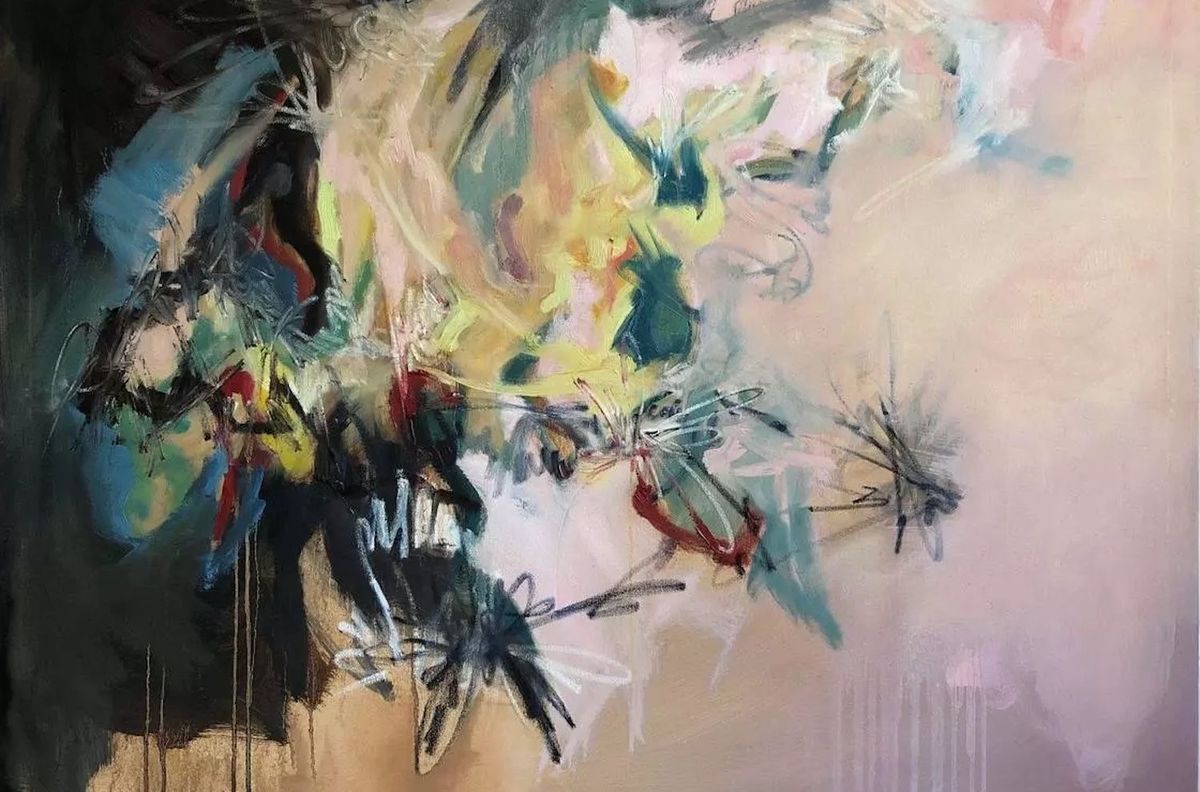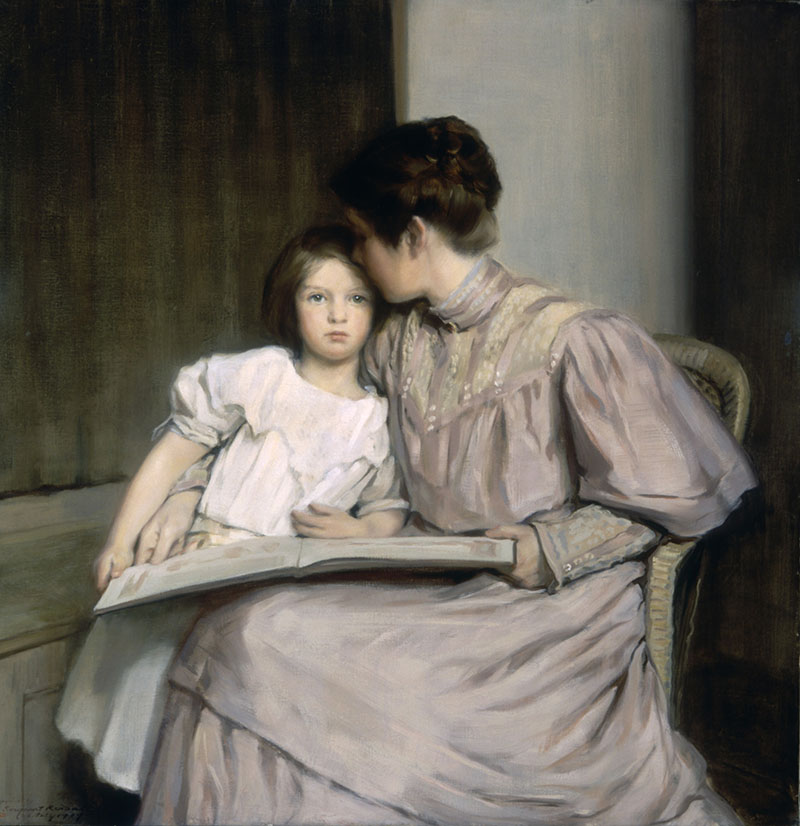From vibrant oils to intricate threadwork, discover how Sophie Anne Wyth connects intuition, movement, and the fragility of the present moment through her deeply personal process.
By Rise Art | 06 Jan 2025
Your practice began through art therapy, which introduced spontaneity to your work. How does this spontaneity influence your process when approaching a new painting?
The impact of it is fundamental as it allows me to create without worrying about the result. As my practice evolved, it became a lot more directed but I keep from this initial approach the energy to start, avoiding any writer’s block or its equivalent. I give myself the freedom to make mistakes, be joyful about paint and I focus my attention on the act of creating itself.
Your art spans both abstract and figurative styles. How do you decide which approach to take when exploring themes like human psychology, sex, and love?
I’ve actually moved away from figurative art in recent years. I am currently obsessed with how colours vibrate next to each other, how some pop and others recede and what it says. Balancing shapes and creating balance is what currently dominates my practice. I want to represent the fragility of an instant, show how things are in constant movement and bound to change. I want to capture the beauty, the angst, and the general essence of the present.

You’ve mentioned that your fashion background influences your art, particularly in terms of elegance and rigour. Could you describe how your experience in fashion shapes your mark-making and composition in painting?
The overlap between fashion and art is not a conscious one. For a long time, I thought of them as very separate things. I have recently started to play with colours with threads and embroideries instead of paint, creating abstracts this way. Making these soft paintings has been freeing as I made them using my sewing skills but deliberately not following any stitching rules, once again bringing freedom and play to the work.
Above all, it is very important to me that my art bears a form of elegance. The marks are considered and somehow contained, making sure the viewer is held and grounded in a certain aesthetic. I don’t know if it is important to me because I come from the fashion world, or if I ended up in fashion because this concept is important to me. But I truly believe that beauty impacts our lives massively, and that the environment we evolve in can support or hinder us.

Your work has been described as incorporating both elegance and grit. How do you balance these opposing qualities in your paintings, and how do they reflect your personal or emotional landscape?
I suppose this is how the continuous quest of oneself presents in my work. Each painting is an internal fight, a push to get closer to what I truly want to say. It is troubling that the meaning of each work is being revealed as it is created. I am constantly surprised by my own work, and I think it is why I keep making it. I get to understand a bit more about myself and the world with each painting. The key is to not think but feel, and be guided from within for each mark. The discomfort can be subtle and brought by colours that are just a bit off, not all together displeasing but also not fully comfortable.

Human psychology seems central to your work. How do you channel personal emotional experiences or broader psychological themes into your art without being too literal?
The theme traverses me and I discover at the end of the work what I was trying to say all along. I am never too literal when I let intuition drive my hand. One colour calls for another and a shape for another. None of these things mean anything, they are moments and thoughts transformed into images. My work is like a meditation, lived in the moment and delivering meaning from within. I am always amazed how each work can be explained, the theme I quietly worked with in the background detailed with words once finished, when I didn’t even know I was putting these particular things in. They become clear once the work is finished. This is also why the titles are always given once the work is finished, once I understand it. Each painting is a research, some bring answers, most bring more questions!
Do you feel that your art offers you a sense of emotional catharsis or personal revelation, similar to the benefits one might experience in art therapy?
My art initiated in therapy but has evolved since. There is an internal quest, but I now think a lot more about my audience and direct it in a way that can be received and benefits the viewer. It is not a therapy for me but it is a way of remaining connected to myself and my emotions. I would compare it to meditation, which I don’t think can replace actual therapy work but is definitely an important support for a full life.

You’ve exhibited in both solo and group shows, including the Every Woman Biennial. Do you feel that these different contexts—solo versus collective exhibitions—impact the way your work is perceived?
During a solo show the whole space is yours to explore and create a conversation between pieces. For a group show, like Every Woman Biennial, you are a guest amongst others, and your piece resonates with works you didn’t know before the show. I like the discovery element in group shows, seeing how your piece has been placed in relation to others. It is also a very good way of being discovered and to meet excellent artists. Both set ups are important.
You’ve been a finalist for prestigious awards like the Celeste Prize. How has this recognition impacted your artistic journey and growth as an artist?
Recognition is necessary, it helps you to believe in yourself. Each external validation and peer recognition is a push in the right direction. That said, the key is to enjoy the achievements as well as to remain focused on the next goal, to never get complacent or self-satisfied. I just try to make sure I enjoy every step.

What kind of feedback or reactions do you receive from viewers and collectors who connect with the deeply personal and therapeutic aspects of your art?
This always makes me very happy when people comment on my work and tell me how it helps them question and see things differently. People mostly comment on the energy the work gives them or the soothing aspect of it. It seems that the fluidity and solidity of it comes through, and the sense of being held. There is no single response I expect from it, but whenever it makes people feel and respond I feel content.
Your work reflects your personal experiences and emotions. As you evolve, how do you see your themes or style changing in the next phase of your artistic practice? And what challenges do you face when sharing personal experiences with the public?
One recurring aspect of my work is that it surprises myself. It is what keeps me interested in it, the constant discovery of it and parts of myself within it. So my style changes “in spite” of me. I am not really choosing to introduce a new style or different methods. It comes from within and I don’t just allow but follow the impulses. I have in the past not allowed some marks or a certain fluidity to come through. I was amazed to see it presenting itself again a few years later, when I was ready. In terms of sharing personal experiences, abstraction is such that it is not literal and therefore doesn’t make me feel too exposed.

Do you have any upcoming exhibitions or projects where you’ll be exploring new themes or techniques?
I would love to develop a larger version of my thread and needle works. It would be interesting to use different widths of yarn, mimicking the size of the brushes, bringing in more texture. My existing embroideries are of a smaller size and have just been exhibited in a group show at Southwark Park Galleries. I will continue to explore the movement and fragility of all things in my abstract oil paintings on all scales.










